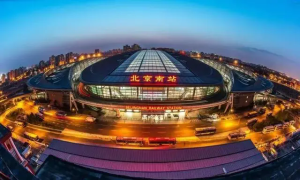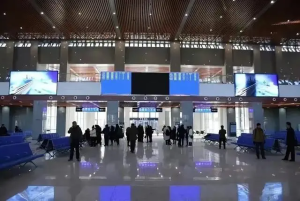Introduction to Beijing South Railway Station
If you travel a lot by high-speed rail in China, do you know which was the first high-speed rail station in China?
Don’t think it is Shanghai Station, Wuhan Station or Nanjing South Station, these are wrong.
China’s first high-speed rail station is actually Beijing South Railway Station!
Yes, it is the station shaped like a flying saucer, it is the station with an annual passenger flow of 150 million, it is the comprehensive transportation hub that integrates a variety of transportation modes, and it is the high-speed rail station with completely independent intellectual property rights!

Beijing South Railway Station is the pride of China’s high-speed rail and the starting point of China’s high-speed rail.
The history of Beijing South Railway Station can be traced back to the late Qing Dynasty.
In 1897, the Qing government built Majiapu Station in the south of Beijing, which was the earliest railway station in Beijing, connecting the Beijing-Han railway and Beijing-Shenyang railway.
In 1902, Majiapu Station was renamed Yongdingmen Station and became the traffic fortress of South Beijing.
In 1988, Yongdingmen Station officially changed its name to Beijing South Station, and began to undertake passenger transport tasks in Beijing-Tianjin, Beijing-Kowloon and other directions.
In 2006, the old Beijing South Railway Station ceased operation and began to close the station, in order to meet the new mission of becoming a high-speed rail station.
In 2008, the Beijing-Tianjin Intercity Railway, China’s first high-speed railway in the true sense, was put into operation, and Beijing South Railway Station was reopened as the starting station between Beijing and Tianjin.

The features of Beijing South Railway Station are amazing.
Beijing South Railway Station building for the double dome, the shape of the oval structure, from a distance like a flying saucer, from the north and south directions, the central main station room slightly raised, east and west sides of the two span steel structure awnings, similar to the transverse stretch of the hall of prayer for good years, this is because the design specifically integrated classical architecture “three eaves” traditional cultural elements.
The design of the station building of Beijing South Railway Station is not only beautiful and atmospheric, but also scientific and reasonable, which can effectively prevent rain and snow accumulation and ensure the safety and comfort of the station building.

The central roof of Beijing South Railway Station installed 3264 solar panels with a total power of 245 kilowatts, creating the largest public building installation photovoltaic power generation system in China, which is very in line with the current trend of energy conservation and environmental protection, and has become a demonstration building.
The photovoltaic power generation system of Beijing South Railway Station can not only provide part of the electricity for the station, but also transmit excess electricity to save resources for the society and reduce pollution for the environment.
Beijing South Railway Station also realizes the seamless connection and zero transfer of subway, national railway, bus and other modes of transportation, which provides great convenience for passengers.
The underground level of Beijing South Railway Station is a transfer station for subway lines 4 and 14, which can directly reach various areas of Beijing.
The underground second floor of Beijing South Railway Station is the waiting hall of the National Railway, with 24 waiting rooms, which can accommodate 15,000 people waiting for the train at the same time.
The ground floor of Beijing South Railway Station is the departure floor of the National Railway, which has 24 platforms and can stop 48 trains at the same time.
The second floor of Beijing South Railway Station is the arrival floor of the National Railway, with 16 baggage carousels, which can quickly provide luggage service for passengers.
The ground three floors of Beijing South Railway Station are the transfer floors for buses and taxis, and there are a number of bus lines and taxi stops, which can easily transport passengers to their destinations.
The design of Beijing South Railway Station fully considers the needs and experiences of passengers, and realizes the efficient connection of various modes of transportation, which provides valuable experience for the construction of other high-speed railway stations.
Beijing South Railway Station is one of the busiest stations in China, with 150 million passengers annually, equivalent to one-tenth of the country’s population.Introduction to Beijing South Railway Station